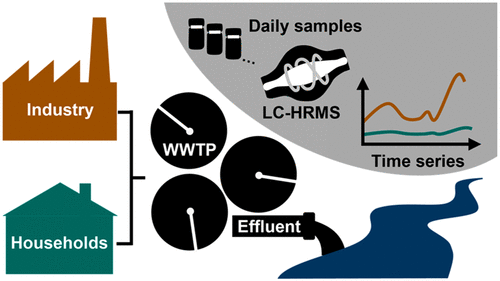当前位置:
X-MOL 学术
›
Environ. Sci. Technol.
›
论文详情
Our official English website, www.x-mol.net, welcomes your
feedback! (Note: you will need to create a separate account there.)
Assessing Emissions from Pharmaceutical Manufacturing Based on Temporal High-Resolution Mass Spectrometry Data.
Environmental Science & Technology ( IF 10.8 ) Pub Date : 2020-03-25 , DOI: 10.1021/acs.est.9b07085 Sabine Anliker 1, 2 , Martin Loos 3 , Rahel Comte 1, 2 , Matthias Ruff 1 , Kathrin Fenner 1, 2, 4 , Heinz Singer 1
Environmental Science & Technology ( IF 10.8 ) Pub Date : 2020-03-25 , DOI: 10.1021/acs.est.9b07085 Sabine Anliker 1, 2 , Martin Loos 3 , Rahel Comte 1, 2 , Matthias Ruff 1 , Kathrin Fenner 1, 2, 4 , Heinz Singer 1
Affiliation

|
This study presents a nontarget approach to detect discharges from pharmaceutical production in municipal wastewater treatment plant (WWTP) effluents and to estimate their relevance on the total emissions. Daily composite samples were collected for 3 months at two WWTPs in Switzerland, measured using liquid chromatography high-resolution mass spectrometry, and time series were generated for all features detected. The extent of intensity variation in the time series was used to differentiate relatively constant domestic inputs from highly fluctuating industrial emissions. We show that an intensity variation threshold of 10 correctly classifies compounds of known origin and reveals clear differences between the two WWTPs. At the WWTP receiving wastewater from a pharmaceutical manufacturing site, (i) 10 times as many potential industrial emissions were detected as compared to the WWTP receiving purely domestic wastewater; (ii) for 11 pharmaceuticals peak concentrations, >10 μg/L and up to 214 μg/L were quantified, which are clearly above typical municipal wastewater concentrations; and (iii) a pharmaceutical not authorized in Switzerland was identified. Signatures of potential industrial emissions were even traceable at the downstream Rhine monitoring station at a >4000-fold dilution. Several of them occurred repeatedly, suggesting that they were linked to regular production, not to accidents. Our results demonstrate that small wastewater volumes from a single industry not only left a clear signature in the effluents of the respective WWTP but also influenced the water quality of one of Europe’s most important river systems. Overall, these findings indicate that pharmaceutical production is a relevant emission source even in highly developed countries with a strong focus on water quality, such as Switzerland.
中文翻译:

基于时间高分辨率质谱数据评估制药生产的排放。
这项研究提出了一种非目标方法来检测市政废水处理厂(WWTP)废水中制药生产的排放,并估算其与总排放的相关性。在瑞士的两个污水处理厂收集3个月的每日复合材料样品,使用液相色谱高分辨率质谱仪进行测量,并为检测到的所有特征生成时间序列。时间序列中强度变化的程度用于将相对恒定的国内投入与波动剧烈的工业排放区分开来。我们显示强度变化阈值10正确地分类了已知来源的化合物,并揭示了两个污水处理厂之间的明显差异。在污水处理厂接收制药厂的废水,(i)发现的潜在工业排放量是仅接收生活污水的污水处理厂的十倍;(ii)对于11种药物的峰值浓度,定量了> 10μg/ L和高达214μg/ L,明显高于典型的城市废水浓度;(iii)确定了在瑞士未授权的药品。甚至在下游莱茵监测站以> 4000倍的稀释度也可以追溯到潜在的工业排放特征。其中有几次反复发生,表明它们与正常生产有关,而不是与事故有关。我们的结果表明,来自单个行业的少量废水不仅在相应的污水处理厂的废水中留下了鲜明的标志,而且还影响了欧洲最重要的河流系统之一的水质。总体,
更新日期:2020-03-26
中文翻译:

基于时间高分辨率质谱数据评估制药生产的排放。
这项研究提出了一种非目标方法来检测市政废水处理厂(WWTP)废水中制药生产的排放,并估算其与总排放的相关性。在瑞士的两个污水处理厂收集3个月的每日复合材料样品,使用液相色谱高分辨率质谱仪进行测量,并为检测到的所有特征生成时间序列。时间序列中强度变化的程度用于将相对恒定的国内投入与波动剧烈的工业排放区分开来。我们显示强度变化阈值10正确地分类了已知来源的化合物,并揭示了两个污水处理厂之间的明显差异。在污水处理厂接收制药厂的废水,(i)发现的潜在工业排放量是仅接收生活污水的污水处理厂的十倍;(ii)对于11种药物的峰值浓度,定量了> 10μg/ L和高达214μg/ L,明显高于典型的城市废水浓度;(iii)确定了在瑞士未授权的药品。甚至在下游莱茵监测站以> 4000倍的稀释度也可以追溯到潜在的工业排放特征。其中有几次反复发生,表明它们与正常生产有关,而不是与事故有关。我们的结果表明,来自单个行业的少量废水不仅在相应的污水处理厂的废水中留下了鲜明的标志,而且还影响了欧洲最重要的河流系统之一的水质。总体,











































 京公网安备 11010802027423号
京公网安备 11010802027423号